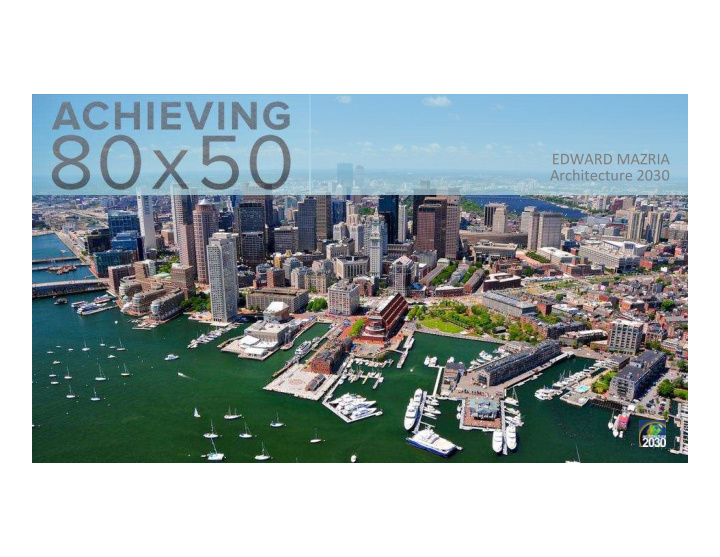



EDWARD MAZRIA Architecture 2030
60% An area equal to 60% of the entire building stock of the world … During the next two decades, over 80 billion m 2 (900 billion ft 2 ) of new and rebuilt buildings will be constructed in urban areas worldwide. Sources: UN Habitat; Adapted from State of the World’s Cities 2010/2011 , McKinsey Global Institute.
or the equivalent of building and rebuilding a New York City every 35 days … with energy and emissions patterns locked-in for 80 to 120 years! Sources: UN Habitat; Adapted from State of the World’s Cities 2010/2011 , McKinsey Global Institute.
Urban environments are responsible for 75% of all human-produced global greenhouse gas emissions. UN Habitat
o C planetary warming threshold, In order to stay under the 2 we must phase out CO 2 emissions in urban environments by about 2050
Mayor Marty Walsh (including Boston)
BOSTON CLIMATE ACTION PLAN Greenhouse Gas Emissions Progress and Goals 2005–2013 ���������������������������������������������� ��������������������������������������������� Millions of Metric Tons of GHGe 2005 8 fuel switching total 17% 2013 6 25% 2020 buildings 4 73% of total ������������������� 2 80% 2050 0 ‘05 ‘06 ‘07 ‘08 ‘09 ‘10 ‘11 ‘12 ‘13 Year 2020 2050 ������������������������������������������������� �����������������������������������������������������
? There are about 724 million sf of buildings in Boston. Boston is adding about 7 million sf new buildings each year. Boston’s buildings are responsible for: • 73% of the City’s emissions, and • 93% of its electricity consumption.
? deep efficiency renovations + renewable energy high-performance new building design
RESIDENTIAL / COMMERCIAL (Average building energy consumption) 100 VOLUNTARY STRETCH CODES 90 • Fast track permitting • Density bonus 80 • Tax credits / deductions • Rebates / reduced fees 70 • PACE financing • On-bill repayment 60 (20% and 40% IECC 2015 2016 stretch code) ASHRAE 90.1 2013 50 (40% and ZNE 20% Code 2019 stretch code) 40 Building Energy 2022 40% Code CODES (ZNE stretch code) 30 (near ZNE) on-site or off-site 20 renewables 10 2030 ZNE 0 zEPI Scale developed by NBI / RESNET
Existing Buildings = 724 million sf • City/State = 67 million sf, carbon neutral by 2030 • Colleges and Universities – carbon neutral by 2030 + Building Energy Building Construction INTERVENTION POINTS CODES + stretch codes • New Buildings = about 7 million sf / yr • Major Renovations • Building Purchases = about 12 to 14 million sf / yr (58% to 68% of the existing building stock by 2050)
CODE COMPLIANCE NEW BUILDINGS & MAJOR RENOVATIONS + Meet the energy codes • efficiency + on-site renewables BUILDINGS PURCHASES (buyer) Meet the energy codes • efficiency + on-site renewables Building Energy Building Construction INTERVENTION POINTS CODES Meet the energy codes • efficiency + off-site renewables • New Buildings (within state or metro area) • Major Renovations Non-intrusive efficiency req. • + off- site renewables within • Building Purchases one year of purchase
+ + Building Energy Building Construction Renewable Energy INTERVENTION POINTS APPLICATIONS CODES • New Buildings • On-Site Renewables • Major Renovations • Off-Site Renewables • Building Purchases
ADDITIONAL TAX REVENUE TO: • renovate public housing • fund training programs • fund incentives for stretch codes
MEET THE 80x50 TARGET CREATE JOBS REDUCE ENERGY COSTS
THANK YOU EDWARD MAZRIA Architecture 2030 www.architecture2030.org
Recommend
More recommend